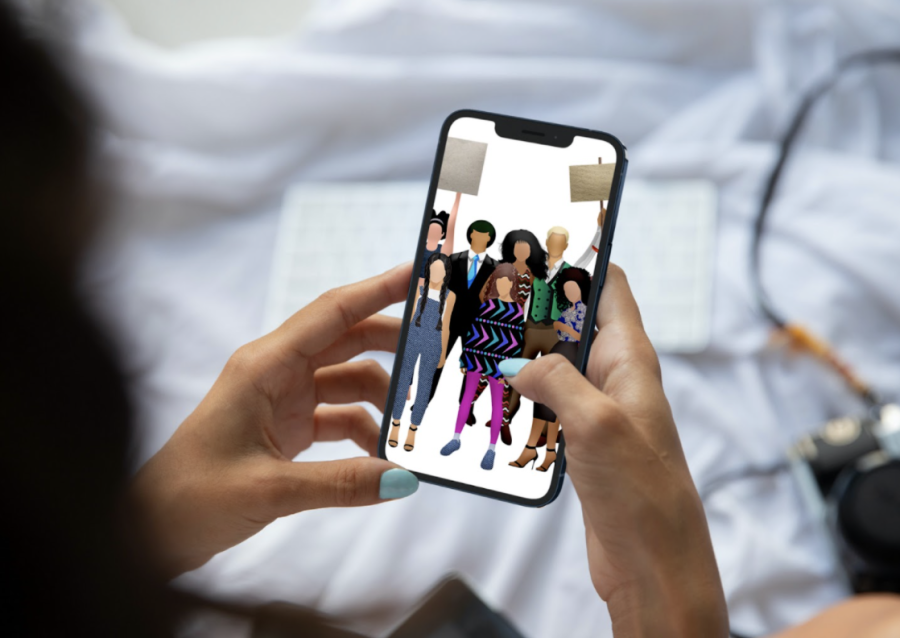Post vs. Protest: Put the Act in Activism
March 1, 2022
POV: It’s 2020. Bored in quarantine, you open your Instagram app yet again. Your feed is flooded with black squares and #BLMs. You decide to post your very own black square to show your solidarity and then…you’ve closed the Instagram app. With a sense of satisfaction, you move on with your day.
Social media can be ground zero for social justice: it’s where conversations are sparked, awareness is spread, and movements are grown. But when activism doesn’t extend past the screen, when activism is limited to only spreading awareness, when all one does is repost an infographic or change a profile picture, that’s performative activism: activism with the goal of increasing social standing instead of genuinely advancing a cause. And performative activism, ironically, can actually end up diminishing social movements.
Performative activism is tempting: it’s so easy to just repost an infographic or type a hashtag. But if everyone is only posting and no one is actually taking action, nothing can actually be done to advance social justice causes. Performative activism is especially problematic because it focuses on the individual: Who’s getting the most likes and comments? Who seems to be the most connected? But social justice is fundamentally about the collective and improving society for everyone on a sustainable and significant scale: that is what activism should be focused on.
So what can you do to turn your performative activism into constructive activism?
The advancement of social justice requires allies. If you want to truly stand in solidarity with historically-marginalized communities, listen to their voices and lived experiences. As an ally, your job isn’t to speak for the people who can’t speak for themselves: everyone has a voice. Instead, you should genuinely listen to and amplify their voices. So, seek out the actual perspectives of marginalized communities: you can find blogs, podcasts, books, and literary magazines dedicat- ed specifically to the stories and voices of historically-underrepresented communities.
Try your best to be intentional about your activism. Before you take any actions, take a moment to ask yourself a few questions. “Am I doing this to genuinely fight for a cause or just to show oth- ers I agree with them on this social justice issue?” “If I do this, how many people are actually being uplifted?” “What impact am I having?” Performative activism usually comes from a place of good intentions, but by being intentional about your actions, you can make your actions have impact rather than acting as meaningless reposts.
Do your research! While the bite-sized information you can find within infographics can help you learn a little more about an existing problem, it is NOT a substitute for independent research. We live in a world where problems don’t have quick solutions or exist in isolation, so it simply isn’t possible to develop a complete understanding of a complex issue from an Instagram post. You can dive into first-hand accounts, explore expert opinions, follow the news, and familiarize yourself with potential legislative solutions. If you have a stronger understanding of an issue, you can effectively advocate for it, on and off of social media.
Be consistent in your support. We can’t only be passionate allies when it’s “trending” during Women’s History Month, Pride Month, Black History Month, or Hispanic Heritage Month. If you genuinely care about advancing equity for these communities, invest time and effort into your activism and allyship throughout the year.
Extend your activism past Instagram; instead, develop a propensity for action in the real world. There are infinitely many ways for you to advance issues you care about (yes, even as a high school student.) You can organize people to vote for leaders whose policy goals align with your values and vision for the country you want to live in. You can meet with your elected representatives to urge them to support or sponsor legislation on issues that matter to you. You can donate and encourage others to join you. And you can attend (or even organize!) demonstrations.
Caring about social justice issues is, without a doubt, a great thing: if there’s anything our world needs, it’s empathetic people doing their best to build a better world for everyone. So, let’s continue using social media to build social justice movements, but let’s do our best to be constructive activists.
Here are a few resources amplifying the voices of marginalized communities:
Podcasts: Silence is Not an Option, The Stoop, The United States of Anxiety, Asian Enough, Tamarindo, Nancy, You Had Me at Black.
Books: The Hate U Give by Angie Thomas, Dear Martin by Nic Stone, Between the World and Me by Ta-Nehisi Coates, Hood Feminism: Notes from the Women That a Movement Forgot by Mikki Kendall, Sitting Pretty: The View from My Ordinary Resilient Disabled Body by Rebekah Taussig, Modern HER-story: Stories of Women and Nonbinary People Rewriting History by Blair Imani, The Brief Wondrous Life of Oscar Wao by Junot Díaz.







